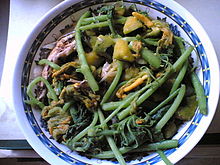Filipino soup-based dish
Dinengdeng Dinengdeng consisting of calabaza squash, shoots and blossoms, and grilled fish. |
| Alternative names | Inabraw |
|---|
| Course | Main course |
|---|
| Place of origin | Philippines |
|---|
| Region or state | Northern Philippines |
|---|
| Associated cuisine | Filipino cuisine |
|---|
| Serving temperature | Hot |
|---|
| Main ingredients | Bagoong, vegetables, fish, meat |
|---|
| Variations | Buridibod, sari sari |
|---|
| Similar dishes | Pinakbet |
|---|
Dinengdeng (also called inabraw) is a dish of the Ilocano people of the Philippines, similar to pinakbet.[1] It is classified as a bagoong (fermented fish sauce) soup-based dish. Unlike pinakbet, dinengdeng contains fewer vegetables more soup base.[2]
A simple meal to prepare was necessary for the Ilocano, who often labored in labor-intensive agriculture industries. Another characteristic of Ilocano cuisine is that dishes are either salty or bitter which means dishes that went well with rice. Dinengdeng, like its more festal sibling pinakbet, is a dish best enjoyed with rice. However, because dinengdeng requires fewer ingredients, it is able to be prepared daily.[3]
Vegetables
Many of these vegetables are easily accessible and are grown in backyards and gardens of most Ilocano households. The dish may contain a numerous combination of the following vegetables:[4][5]
- Aba (taro), corms
- Alukon (Broussonetia luzonica), blossoms
- Balangkoy (cassava), tubers
- Balatong (mung beans), dried beans
- Bukel ti otong (black-eyed peas), dried beans
- Daludal (taro), shoots
- Kabatiti (luffa), gourd
- Kalunay (amaranth), leaves
- Kamotig (sweet potato), tubers and leaves
- Karabasa (calabaza), squash, blossoms, young shoots
- Kardis (pigeon pea), shelled beans
- Katuday (West-Indian pea), shelled beans
- Kutsay (garlic chives), leaves
- Mais (sweet corn), cobs
- Marunggay (moringa), leaves and pods
- Okra (okra), fruit
- Otong (black-eyed peas), young pods
- Otong (snakebeans), young pods
- Pallang (winged bean), fruit
- Parda (parda bean), young pods
- Parya (bittermelon), leaves and unripe fruit
- Patani (lima beans), shelled beans
- Rabanos (rat-tail radish), pods
- Rabong (bamboo shoots), shoots
- Sabunganay (banana), blossoms
- Saluyot (jute), leaves
- Sayote (chayote), fruit and young shoots
- Sili (chili peppers), leaves and unripe fruits
- Tabungaw (bottle gourd), gourd
- Talilong (Talinum), shoots
- Tangkoy (winter melon), gourd
- Tarong (eggplant), fruit
- Tugi (yams), and wild potatoes
- Uong (mushrooms)
Dried shrimp are dried fish often added to season the fish broth.[6] Leftover stale meats can be added to ameliorate the dish, known as sagpaw or garnish, that would be otherwise simple such as: fried or roasted fish, bagnet, lechon, or even fast food fried chicken. It could be seasoned with aromatics like bawang (garlic), sibuyas (native shallots), or laya (ginger), or soured with kamatis (tomatoes) or pias (bilimbi).[7]
Variations
In variations where kamotig (sweet potato tubers) are featured as a main ingredient, it is called buridibod. The sweet potato tubers may sometimes be cooked to the point where it disintegrates creating a thicker soup.[8][9]
In Hawaii, despite the Tagalog sounding name, it is known as sari-sari (Tagalog lit. 'variety'), referring to the various Ilocano vegetables the dish may contain as a result of the strong Ilocano diaspora.[10] The term was coined in 1974 by Theo Butuyan of Pangasinan at he and his wife's restaurant "Elena's" in Waipahu.[11] His version contains eggplant, bottle gourd, water spinach, tomatoes and onions, simmered with shrimp and crispy pork belly.[12]
In popular culture
Dinengdeng Festival
The annual "Dinengdeng Festival" is the official festive event of the municipality of Agoo, La Union, Philippines held in the summer.[13][14] The festival is held in celebration of the dish and to promote tourism. A large banga (clay pot) is used symbolize the festival, called the "Big Banga". It is used during the event in cooking the dinengdeng.
This festival replaces the old theme of tobacco, an important agricultural crop of Agoo. However, tobacco festivals are commonly celebrated throughout the country in different towns.[15] The goal of the local government desired this festival to be comparable to other prominent festivities in the region, such as the Panagbenga.[16]

